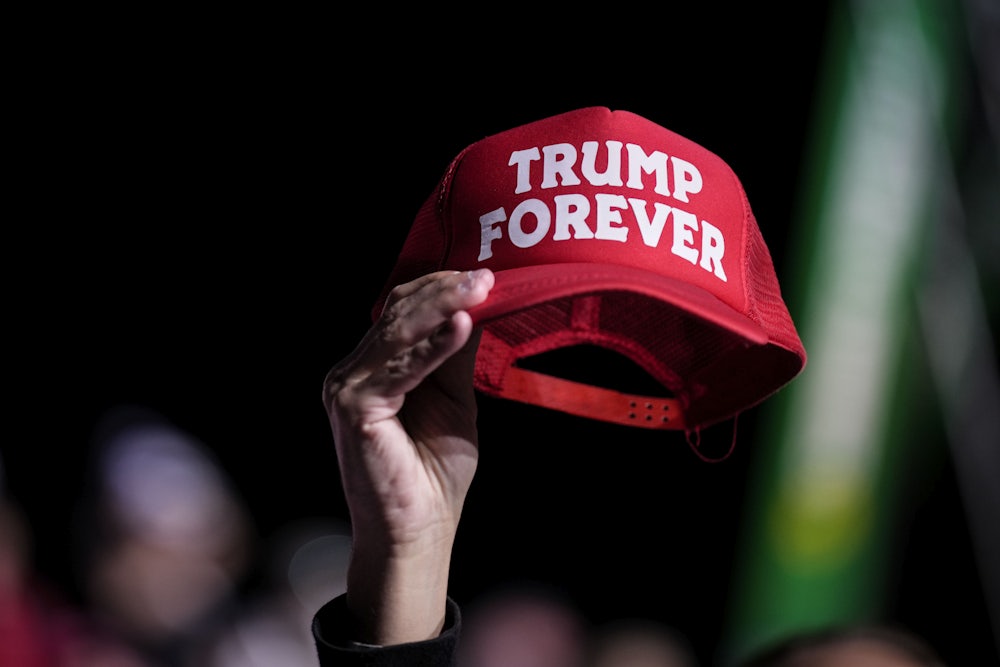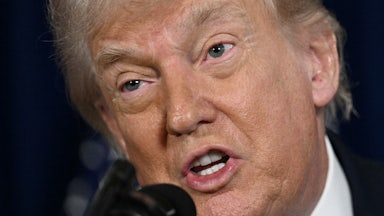One of the important differences between the Democratic and Republican parties in this era of polarization lies in the elites’ attitudes toward their respective bases. Democratic elites—high-level candidates and officeholders, famous consultants like the ones who dominated Democratic politics in the 1990s and 2000s, some large donors—have kept the base at arm’s length, and often sprinted away from it or made dramatic, showy moves to distance themselves (look up Sister Souljah moment—I was there at that Washington hotel that morning and knew instantly that it would live on in history as it has).
Republican elites, in contrast, have hugged the base. There are a lot of reasons for this. For starters, the GOP base is larger. This is a fact that’s almost never mentioned in the day-to-day media, but it explains a lot about our politics, from why the GOP is a more ideologically homogeneous party to why Republicans have an easier time of it gerrymandering districts. There are just a lot more conservatives in America than liberals—36 percent to 25 percent, respectively, according to Gallup. And back when Bill Clinton won the presidency, it was 36 to 17!
It’s also just how modern movement conservatism is built psychologically. Modern liberals, before the social media age, were the establishment, and were trained to let their thinking be guided by NPR and The New York Times. Modern conservatives were insurrectionists weaned on Rush Limbaugh and Fox News.
So the history of the last 30 years has been, in essence: Democrats are in a tug of war about whether to distance themselves from the base or pander to it (they’ve done some of both), while Republicans have had no such internal struggle. It’s been pander, pander, pander, even when the base is rioting upon and defacing the main temple of our democracy (with two or three honorable exceptions).
That could be about to change. In fact, in 2024, both scripts might flip.
I’ll start with the Democrats. If Joe Biden stays healthy and decides to run again, there will likely be no primary challenges from either left or center. I suppose a challenge from the left can’t be entirely ruled out, if Biden is seen in those quarters as having become too corporate-friendly (there is talk that National Economic Council chairman Brian Deese, over whom progressive policy wonks swoon, will leave and be replaced by a Wall Streeter).
But it doesn’t seem likely. Biden has done a good job of holding the party together, and the left—that is, the left within the party; there’s another left that considers the Democrats capitalist stooges, but that left isn’t very large electorally—is reasonably happy with what the administration has accomplished. The centrists appear to be more satisfied than not as well. For them, Biden is a safety valve—a good, churchgoing Catholic and anti–police defunder whose presence ensures that the party doesn’t nominate someone centrists consider unelectable.
It’s also my sense that everyone has learned from these last two tough years that Democrats can only chalk up Ws by compromising with one another, however distasteful it may be. The House progressives came to see that they really had no choice but to accept that Joe Manchin could dictate the terms and bounds of the Inflation Reduction Act. It was a fraction of what they wanted, but that didn’t stop them from voting for it and touting it after passage as if it were the second coming of Medicare and Medicaid.
So assuming Biden runs, the Democratic elites and the party base won’t be that far apart, and they’ll be largely united around a pretty progressive economic agenda. If Biden can’t or doesn’t run, it’s a different story, but even then, I very much doubt that 2016-style bitterness would emerge, because the party establishment is to the left of where it was in 2016 and because Hillary Clinton was, to the party left, such a potent symbol of neoliberalism.
Now let’s get to the fun part.
Let’s assume a semi-multicandidate GOP presidential field. I wouldn’t expect 17 candidates, as there were in 2015–16, because back then Donald Trump was initially a laughingstock, so lots of people thought, “Hey, I could pull this off.” Now most people acknowledge that he has his 30 percent or so. I’d look for a seven- or eight-candidate field: Trump, Ron DeSantis, Mike Pence, Liz Cheney, Glenn Youngkin, Chris Sununu, Mike Pompeo. There may be a couple more.
The elites will be divided between Trump and Never Trump. They already are.
Before we list a few, note my definition of the Republican elite. It includes, as the Democratic elite does, top elected officials, consultant/insiders, and major donors. But it includes other key figures too: the major players in the right-wing media and social media worlds. The reason is simple: They play a kingmaking role in the GOP in a way that MSNBC and The New York Times just do not on the Democratic side. Rupert Murdoch looms like a Macy’s balloon over GOP politics, whereas I would imagine you (and most elected Democrats) don’t even know who the head of MSNBC is, and I’m guessing Rashida Jones is fine with that.
We are seeing signs that the GOP elite is done with Trump. We should stop and note, by the way, that this is not out of moral disapprobation. It’s because he’s perceived as having lost the party the Senate. If Mehmet Oz, Blake Masters, and Don Bolduc had won their Senate races, as far as the GOP elites are concerned, Trump could invite antisemites like Ye (Kanye West) and white supremacists like Nick Fuentes to Mar-a-Lago every weekend. But since he’s a loser, doing that, as he did Friday, is just one more ground for divorce.
But even having said that, this elite-Trump divorce will be a slow process. The GOP elite includes Mitch McConnell, who I presume will be anti-Trump. But it also includes Lindsey Graham, who’s still tweeting favorably about Trump, with a finger in the air. It includes major GOP donors like Stephen Schwarzman and Robert and Rebekah Mercer, who’ve said it’s time to move on from Trump. But it surely includes many donors who aren’t yet ready to declare themselves anti-Trump, just in case.
And with respect to the media power brokers, that elite also includes now Elon Musk, who over the weekend announced his preference for DeSantis, his fellow enemy of the “woke mind virus.” But it includes Tucker Carlson, whom I don’t watch but who from what I read appears to be hedging his bets for now (he recently said the old Twitter ban on Trump was an attack “on the possibility of a free society”).
And perhaps most notably, it includes Murdoch. If his News Organization turns firmly against Trump, the GOP nomination may well come down to the question: Will Murdoch have the power to turn Trump’s base against him, or will the base have the power to make even Mighty Rupert capitulate to Trumpism one more time?
A chunk of the base has turned on Trump, it’s true. But always remember—if he holds his 30 percent, he can win a lot of primaries in multicandidate fields (in the first four states in 2016, he averaged 34.4 percent, winning three). If he starts to look like a winner—well, there is zero history of the Republican elite actually having the backbone to stand up to him.
This time may be different. If it is, we’ll see a GOP civil war on a scale not seen since 1976, when Ronald Reagan challenged incumbent Gerry Ford. It would almost surely even outpace that one, since Reagan and Ford at the end of the day were both good Republicans in a more civil time.
It’s taken 30-plus years, but by 2024, we may finally find ourselves at the point where Democratic elites and base are getting along just fine, while it’s Republican elites who recoil from the monster they created. That would be a shift that could realign politics for years to come.












